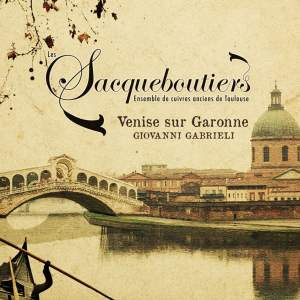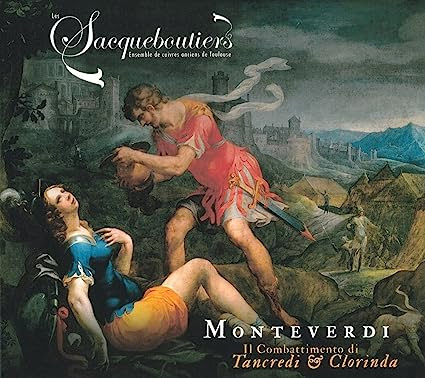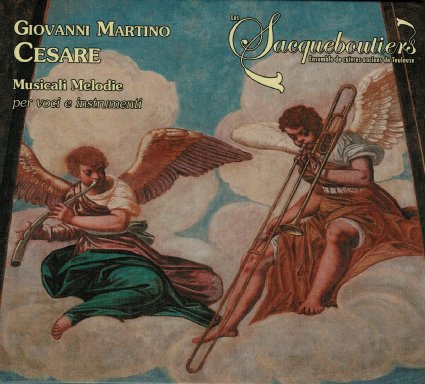Program: #19-46 Air Date: Nov 04, 2019
For 45 years this superb ensemble has brought the world of early brass and winds alive; this week, the early Italian baroque.
This program is Free for all, thanks to this generous Preservation Grant:
NOTE: All of the music on this program is from the ensemble Les Sacqueboutiers de Toulouse.
Since their founding in 1976, Les Sacqueboutiers have dedicated themselves to rediscovering the practice of ancient brass and the vast repertoire of the Renaissance, the golden age of their instruments. They have established themselves as one of the most imaginative early music ensembles. The search for musical excellence remains the driving force of their work. Selected as Ensemble of the Year at the Victoires de la Musique Classique 2008, they collaborated with the most prestigious ensembles to perform repertoires ranging from the Renaissance to Mozart: Hesperion XXI, The Arts Florissants, The Royal Chapel, The Great Stable and the Chambre du Roy, the vocal ensemble Clément Janequin.
The Sacqueboutiers are not limited to the repertoire of the Renaissance. Their creativity leads them to design shows that combine ancient music with other artistic universes: contemporary music, dance, the world of puppetry, jazz, literature, ethnomusicology.
For more information: https://www.les-sacqueboutiers.com/
I. Venise sur Garonne: Giovanni Gabrieli. Flora CD 3314.

During the 16th century, in San Marco, Venice, two organs faced each other in the loft surrounding the choir. Both organist positions were occupied by famous musiciens such as Giovanni Gabrieli, pupil of his uncle Andréa, and Gioseffo Guami, a pupil of Adrian Willaert.
The location of these instruments allowed these musiciens to compose pieces for several groups of voices which were still called 'choirs'. The part played by these 'choirs' became more important, and finally the composition of purely instrumental music resulted in the conception of magnificent 'Canzoni' whose style was progressively exported to the whole of 17th century Europe.
The programme 'Venise sur Garonne' (Venice on the Garonne river) gathers the most prominent pieces of work mostly devoted to cornetti and sackbuts and specially the 'Canzoni' requiring the largest number of instruments, up to 22 distinct voices distributed among 5 different choirs. This form of composition, highly appreciated during the baroque period, progressively disappeared with the emergence of the symphony orchestra.
Thanks to the magnificence of this Venetian repertoire, so representative of ancient brass instruments Les Sacqueboutiers naturally chose to pay tribute to the great polyphonist of this period, Giovanni Gabrieli.
- Symphoniae Sacrae (1587): Canzon duodecimi toni in eco à 10 04:04
- Symphoniae Sacrae (1615): Canzon VIII à 8 03:41
- Symphoniae Sacrae (1597): Canzon duodecimi toni à 10 05:33
- Symphoniae Sacrae (1615): Canzon III à 60 3:06
- Symphoniae Sacrae (1615): Sonata XVIII à 14 06:59
- Symphoniae Sacrae (1597): Canzon noni toni à 12 03:51
- Symphoniae Sacrae (1615): Canzon IV à 60 2:41
- Symphoniae Sacrae (1615): Canzon XVI à 12 04:11
- Symphoniae Sacrae (1597): Sonata « piano & forte » à 8 04:37
- Symphoniae Sacrae (1615): Canzon XVII à 12 03:33
- Symphoniae Sacrae (1615): Canzon prima à 5 02:39
- Symphoniae Sacrae (1597): Canzon septimi & octavi toni à 12 03:12
- Symphoniae Sacrae (1615): Sonate XXI 04:30
- Symphoniae Sacrae (1597): Canzon octavo toni à 12 03:54
- Symphoniae Sacrae (1615): Canzon X à 80 4:10
- Raveri (1608): La Spiritata à 4 03:08
- Symphoniae Sacrae (1597): Canzon quarto toni à 15 04:13
- Symphoniae Sacrae (1615): Canzon II à 6 03:53
- Symphoniae Sacrae (1615): Sonata XX à 22 07:10
Total Runtime: 01:19:05
II. Monteverdi: Il Combattimento di Tancredi & Clorinda. Flora CD 1709.

From Classica France: The original score was "scrupulously respected, and the use of cornets and sackbuts did not require any modification, transposition, rearrangement or adaptation, only account here the expressive power of execution," announces Jean-Pierre Canihac, co-founder of Sacqueboutiers . By trading his original violins and viols for wind instruments, The Battle of Tancred inevitably blunt the edge of the swords and galloping horses. Less descriptive, more allusive, the instrumental narration does not lose anything of its intensity and it agrees very well with the chastised eloquence of Furio Zanasi. The madrigal is ultimately more vocal than ever. In addition to a paraphrase for solo clarinet on this work by Monteverdi, composed in 1969 by Alexander Goehr, the musicians completed their program with a pocket opera (a quarter of an hour) by Paolo Quagliati (circa 1555-1628) in which unites Love, Apollo and Orpheus to celebrate beauty and love.
The meeting of the Sacqueboutiers of Toulouse with the warm expression of Adriana Fernandez, the fullness of their sonority, the natural lyricism justify the period appreciations "extolling the ability of the horn to imitate the voice."
We like Jean-Pierre Canihac and his Sacqueboutiers, pioneers of vintage sounds and, as such, involved in so many memorable revivals, with Jordi Savall among others. But some will think they have gone too far in dressing nine the mythical Combattimento de Monteverdi, this masterpiece in the representative genre initially instrumented for a viola da braccio quartet, which has become an opulent concert of baroque brass. However, the transpositions were frequent in the music of the early seventeenth century where cornetti and trombones excelled in the painting of passions and the imitation of the human voice, making vain the reproach of transgression that could be made to this new version , strong of a maajeur trump with the testo (reciting) of Furio Zanasi, already noticed in the very convincing engraving Garrido (K. 617), and which again burns here the words in ardent playwright, but without making quite quite forget the Expressionist testa Expressionist Werner Hollweg, accomplice, at the top of the discography, reading genius atypically Harnoncourt (Teldec).
Everything seems to ensure the album a more than respectable place in the catalog, was the failure of the beach 2, laborious "tribute to clarinet solo Alexander Goehr, the son of the conductor Walter Goehr who was a enthusiastic monteverdien. A misstep that is fortunately forgotten by Carro di Fedelta d'Amore of the Venetian Paolo Quagliati, a carnival entertainment from the very beginning of the Seicento that concludes the recording in the allegorical style required. And the song remains unassailable, equal to what it was in the Combat where, besides Furio Zanasi, shone the ductile soprano of Adriana Fernandez and the fervent tenor of Juan Sancho, Clorinda and Tancredus striking with truth.
Monteverdi: Il Combattimento di Tancredi e Clorinda
Goehr: Paraphrase for solo clarinet on Monteverdi's 'Il Combattimento di Tancredi e Clorina'
- Les Sacqueboutiers
- Jean-François Verdier (clarinet)
Quagliati: Carro di fedelta d'amore
III. Giovanni Martino Cesare: Musicali Melodie. Flora CD 3615.

The sole complete copy of Giovanni Martino Cesare's Musicali Melodie, recorded here, is to be found in the Episcopal Library of Regensburg. Of the 28 numbers listed in the table of contents, 14 of these are Concerti Spirituali with one to five voices and basso continuo, along with 14 instrumental pieces of one to six parts with basso continuo.
In the 14 Concerti Spirituali, the mixture of voices and instruments produces an extraordinary variety of sonority which allows, while underlining the text, to strengthen the musical expression. The instrumentation are rich in multiple conbinations, in permutations of attractive tones.
The legacy that Venetian music bequeathed to musical world at the beginning of the 17th century resides primarily in the relation between instrumental composition and singing.
Les Sacqueboutiers decided to republish this recording dating 1996 because of the exceptional participation of great invited artists gathered around the "hard core"of the brass ensemble.
- La Vittoria, 3'37
- Beata es Virgo, 2'31
- Jubilate Deo, 3'34
- Salve Regina, 2'29
- La Fenice, 3'02
- La Bavara, 2'46
- La Monachina, 2'25
- Isti sunt duae olivae, 2'00
- Sancta Maria, 2'18
- Veni Sponsa Christi, 2'08
- La Lioannina, 2'45
- La Massimiliana, 2'21
- La Augustana, 2'48
- O Domine Jesu Christe, 2'16
- Cantate Dominum, 2'26
- Gabriel Angelus, 2'00
- La Foccarina, 3'41
- La Hieronyma, 1'57
- La Giorgina, 3'28
- O Domine Jesu Christe, 2'36
- Domine Exaudi, 2'23
- Laudate Pueri, 1'55
- Assumpta est Maria, 2'09
- La Gioia, 3'03
- La Famosa, 1'56
- La Constanza, 3'37
- Eco, 2'46
- Benedicam Dominum, 3'15
Composer Info
Giovanni Gabrieli, Monteverdi, Giovanni Martino Cesare
CD Info
Flora CD 3314, Flora CD 1709, Flora CD 3615.
